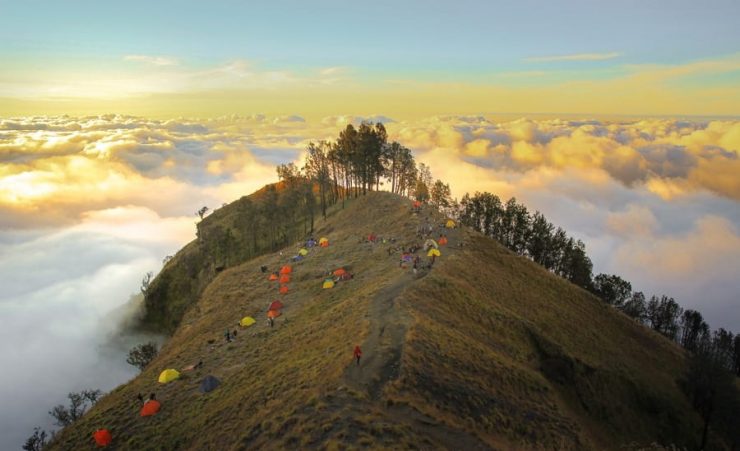IT IS Robert W. Hefner, Indonesianist and Professor of Anthropology at Boston University, United States, who in his book entitled Hindu Javanese: Tengger Tradition and Islam, explained that the people or wong Tengger are descendants of refugees from the Majapahit Kingdom.
In the 16th century, the Majapahit Kingdom allied with the Portuguese against Demak angered the King of Demak, Raden Patah. After several battles, Majapahit, which was centered in Daha, was defeated. This defeat triggered the exodus of the people of Majapahit to the mountains, which are now at the intersection of Lumajang, Pasuruan, Probolinggo, and Malang Regencies.
The origin of the word Tengger gave rise to various opinions. Tengger can refer to the location of this community. There are also those who say ‘Tengger’ comes from the sentence Tenggering Budi Luhur which means ‘noble character’ to describe the ideal character of the Tengger Tribe. Then, there are those who associate it with the legends of Roro Anteng and Joko Seger. The combination of the last two words of a husband and wife produces the word Tengger.
Roro Anteng is the daughter of a dignitary of the Majapahit Kingdom and Joko Seger is the son of a Brahmin. The two lovebirds married and took refuge in Tengger when Majapahit lost to Demak. Joko Tengger later became a leader in the Tengger region, holding the title Purbawisesa Mangkurat Ing Tengger. The descendants of Roro Anteng and Joko Seger later became the Tengger Tribe in East Java.
Quoted from www.goodnewsfromindonesia.id, the Tenggerese still maintain the beliefs of their ancestors from Majapahit. The ancestors of the Tengger tribe adhered to Hinduism. So is their language. The Tenggerese have a different dialect from the current Javanese language. They still use the Kawi dialect mixed with some Old Javanese vocabulary that is no longer used by other Javanese speakers. This is what makes the mingling of the Tenggerese and Javanese in the four regencies limited by language.
However, social and religious life in the Tengger region is fairly cohesive and harmonious. There has never been a clash between the Hindu Tenggerese and the Muslim Javanese. A reflection of that harmony is found in the Mandharagiri Temple, Semeru Agung. This temple is adjacent to the mosque and church.
“It is also the embodiment of harmony and cohesiveness of the Tengger, Javanese, and Madurese tribes who live in Lumajang,” said Edy.
Around 11.00 noon, the sky on Saturday mid-November is shady, the temple yard is filled with tourists and the Tenggerese praying. The atmosphere became crowded when residents and their families delivered offerings to the temple. The view after the prayer was no less boisterous. Residents who generally already know each other spread out mats and sit together enjoying lunch from home. They joked while greeting each other.
“This is the tradition in our village, prayer is also a place to meet and relax,” said Marto, one of the residents.
Not far from Mandharagiri Semeru Agung Temple, there is an Etawa goat farm. One of the best farms is Goatzilla Farm and Café. There are many Etawa goat farms, but this is one of the best. Saiful Siam’s farm is unique because tourists can witness the process of milking goat’s milk to the process of making goat’s milk cheese – which is processed in various types of cheese – to yogurt.
The goat cage is always clean. The owners are very concerned about the cleanliness and health of the Etawa goats, the males for the contest can cost IDR180 million, while the males for raising the goats range from IDR15 to 20 million.
“The cage must always be clean when milked and after milking. There should be no dirt and hair that enters through the nipple. Bad bacteria can enter the nipple and harden the goat’s breast. If that’s the case, in a matter of hours, the goats can die,” said Lutfi Andi, an employee of Goatzilla Farm.
He said, if there is a feather that falls into the milk when it is squeezed, it can damage the aroma of the milk. Replaced with the smell of goats.
According to Lutfi, the Etawa goat is a direct descendant of the Indian goat that was presented to President Soekarno when he visited India. This giant goat with smooth white hair has been bred in Senduro and is a special breed of livestock in the region, which is not found in other areas. The characteristics of this goat, in addition to its gigantic body, it has white fur without horns – even though it is an adult – and has ears that are quite long and twisted. The length of the ears reaches 50 centimeters.
It takes at least a week to explore people’s lives in BTS National Park. That’s what makes us feel like coming back, to not just enjoy the heights of Semeru or the beauty of the mist in the Bromo area. Because, BTS also saves the beauty of culture as well as the friendliness of the residents. [sources/photo special]
















